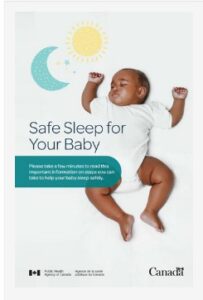Sleep Safe – Infant
You can help lower the risk of sudden infant death syndrome (SIDS) and other infant deaths that happen during sleep time. These steps will help your baby sleep safely.
- Always place your baby on their back to sleep, for every sleep.
- Be smoke-free, before and after your baby is born.
- Breastfeed your baby.
- Give your baby a safe sleep space that has:
- a firm, flat surface with a tightly fitted sheet
- no gaps between the mattress and sides
- no loose, soft bedding, bumper pads, pillows, sleep positioners or toys.
- Room sharing - Place your baby to sleep in a crib, cradle, or bassinet in your room for the first 6 months.
- Practice safe sleep on the go.
The safest place for your baby to sleep is in a crib, cradle, or bassinet, including a bassinet attachment for a playpen.
Learn much more about safe sleep for your baby by clicking here.
Safely Dressing Your Baby for Sleep
Overheating is a risk for SIDS. You can help prevent overheating by:
- Keeping your baby’s room at a comfortable temperature. If it is comfortable for you, it is comfortable for them.
- Using fitted sleepwear. Skip the hat when your baby gets home. Hospitals use them while your baby is still learning to regulate their temperature.
When using sleep sacks be sure they are the correct size for your baby. If the sleep sack is too big, your baby could slip down in it causing overheating or suffocation. If the sleep sack is too small, it can hinder your baby’s movement.
Check your baby’s clothing and sleepwear regularly for loose threads, snaps and zippers that could cause injury.
Swaddling
Swaddling is sometimes used to calm babies. There is a risk of suffocation if your baby:
- gets tangled or covered in the blanket.
- loosens the blanket.
- rolls onto their tummy while still swaddled.
Some tips for safer swaddling:
- Use a lightweight blanket. Make sure it stays away from your baby’s nose and mouth.
- Wrap your baby so they can still move their hips and legs.
- Leave your baby’s hands free so they can show you when they are hungry.
It is important to stop swaddling before your baby can roll.
Swaddling is not safe for your baby when they are on their tummy.
Caution: Products not made for infants sleep:
• Bed-side sleepers (click to expand) »Bed-side sleepersthat attach to an adult bed are not recommended. Your baby can get trapped in the space between the bed and the bedside sleeper. |
• Baby nests or pods (click to expand) »Baby nests or pods(small, portable pads with soft, padded sides) and other soft products like nursing pillows are not recommended for sleep. These products increase your baby’s risk of suffocation. They are not for use in a crib, cradle, or bassinet, or on an adult bed for your baby to sleep in. |
• Inclined sleepers, baby hammocks and crib wedges (click to expand) »Products with a sleep surface that is not flat, like inclined sleepers, baby hammocks and crib wedges, are not recommended – even if your baby spits up a lot. These products can cause your baby to move into a position where they cannot breathe. |
• Highchairs, baby swings, bouncers, strollers, and car seats (click to expand) »Highchairs, baby swings, bouncers, strollers, and car seats are made for babies, but not for sleep. Sleeping in a sitting position can cause your baby’s head to fall forward, which can make it hard to breathe. Babies have suffocated when sleeping in these products. If your baby falls asleep in a highchair, bouncer, or swing, be sure to move them to a crib, cradle, or bassinet. If your baby falls asleep while travelling in a car seat or stroller, move your baby to a crib, cradle, or bassinet when you arrive at your destination. Take off your baby’s snowsuit, raincoat, jacket, and other outerwear once indoors to reduce the risk of suffocation or overheating. |
• Sofas or armchairs, air mattresses and adult beds (click to expand) »Sofas or armchairs, air mattresses and adult beds are not made for your baby to sleep on. They increase your baby’s risk of falling or being trapped and suffocated. The risk is even higher if your baby shares the surface with an adult or other child. |
Services related to this information:
- Contact your Public Health Nurse.
- 811 Health Line (Newfoundland & Labrador) – Call 811 or 1-888-709-2929 / TTY 1-888-709-3555
- 811 is free and confidential. 811 is available 24/7 and can provide support with mental health and addictions issues and more.
- Services formerly offered by the Provincial Mental Health Crisis Line are now offered by 811. Call 811 to speak with a registered nurse who is also a trained crisis intervener.


